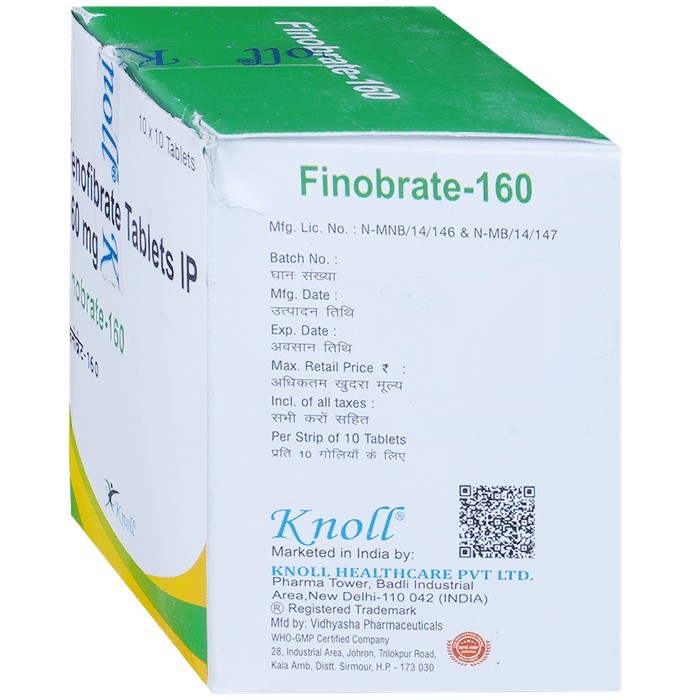Finobrate 160 Tablet
Marketer
Knoll Pharmaceuticals Ltd
Salt Composition
Fenofibrate (160mg)
Overview Finobrate 160 Tablet
Fenofibrate 160mg tablets are prescribed to manage elevated cholesterol. This medication lowers harmful triglycerides and LDL ("bad") cholesterol, concurrently increasing beneficial HDL ("good") cholesterol. Reduced cholesterol levels lessen the likelihood of heart attacks and strokes. Dosage and duration of Fenofibrate 160mg tablets should strictly adhere to your physician's instructions. It can be taken with food anytime, but consistency in daily timing is recommended. High cholesterol often presents no noticeable symptoms, however discontinuing this medication could worsen your condition, potentially elevating cholesterol and increasing cardiovascular risks. Regular cholesterol monitoring is crucial. This medication complements a comprehensive treatment plan encompassing a balanced diet, regular physical activity, smoking cessation, controlled alcohol consumption, and weight management. Maintain a normal diet, minimizing high-fat foods. Common side effects may include nausea, stomach pain, diarrhea, and vomiting. Inform your doctor of all other medications before commencing treatment. Caution is advised if you have kidney or liver impairment. Pregnant or breastfeeding individuals should consult their doctor before using this medication.
Uses of Finobrate 160 Tablet
Elevated cholesterol and triglyceride levels
Major Benefits of Finobrate 160 Tablet:
Consume this medication precisely as directed by your physician, adhering to both the prescribed dosage and treatment length. Ingest the tablet whole; avoid chewing, crushing, or fracturing it. Administer Finobrate 160 Tablet with a meal.
Common Side effects of Finobrate 160 Tablet:
- Abdominal pain
- Diarrhea
- Nausea
- Headache
- Flatulence
- Vomiting
- Increased liver enzymes
- Increased creatine phosphokinase (CPK) level in blood
- Back pain
- Inflammation of the nose
How to use Finobrate 160 Tablet:
Follow your doctor's instructions precisely regarding the dosage and treatment length for this medication. Ingest the tablet whole; do not chew, crush, or divide it. Administer Finobrate 160mg with a meal.
How Finobrate 160 Tablet works:
Fibric acid derivative Finobrate 160mg tablets reduce elevated lipids. This medication decreases triglyceride and low-density lipoprotein (LDL, or "bad") cholesterol concentrations, concurrently increasing high-density lipoprotein (HDL, or "good") cholesterol.
SAFETY ADVICE
 AlcoholUNSAFE
AlcoholUNSAFE
Combining Finobrate 160 Tablet with alcohol is inadvisable.
 PregnancyCONSULT YOUR DOCTOR
PregnancyCONSULT YOUR DOCTOR
Using Finobrate 160mg tablets during pregnancy may pose risks. While human research is scant, animal studies indicate potential harm to the fetus. A physician will assess the potential benefits against these risks prior to prescription. Seek medical advice.
 Breast feedingCONSULT YOUR DOCTOR
Breast feedingCONSULT YOUR DOCTOR
Use of Finobrate 160 mg tablets while breastfeeding is likely inadvisable. Preliminary human evidence indicates potential transfer of the medication into breast milk, posing a possible risk to the infant.
 DrivingSAFE
DrivingSAFE
Driving ability is typically unaffected by Finobrate 160 mg tablets.
 KidneyCAUTION
KidneyCAUTION
Patients with kidney impairment should use Finobrate 160 mg tablets cautiously, potentially requiring dosage modification under medical supervision. Finobrate 160 mg tablets are contraindicated in individuals with severe kidney disease.
 LiverUNSAFE
LiverUNSAFE
Patients with liver disease should not take Finobrate 160 Tablets; its use is contraindicated, especially in severe cases. Medical advice is essential before using this medication.
What if you forget to take Finobrate 160 Tablet :
Should you forget a Finobrate 160 Tablet dose, take it immediately. Nevertheless, if your next dose is imminent, omit the missed dose and resume your usual dosing regimen. Avoid taking a double dose.
Facts to Know About Finobrate 160 Tablet
| Label | Value |
|---|---|
| Chemical Classification | Fibric acid-based compound |
| Developing Habits | No. |
| Type of Treatment | Heart |
| Action Class | Fibrates (PPARα agonists) |









